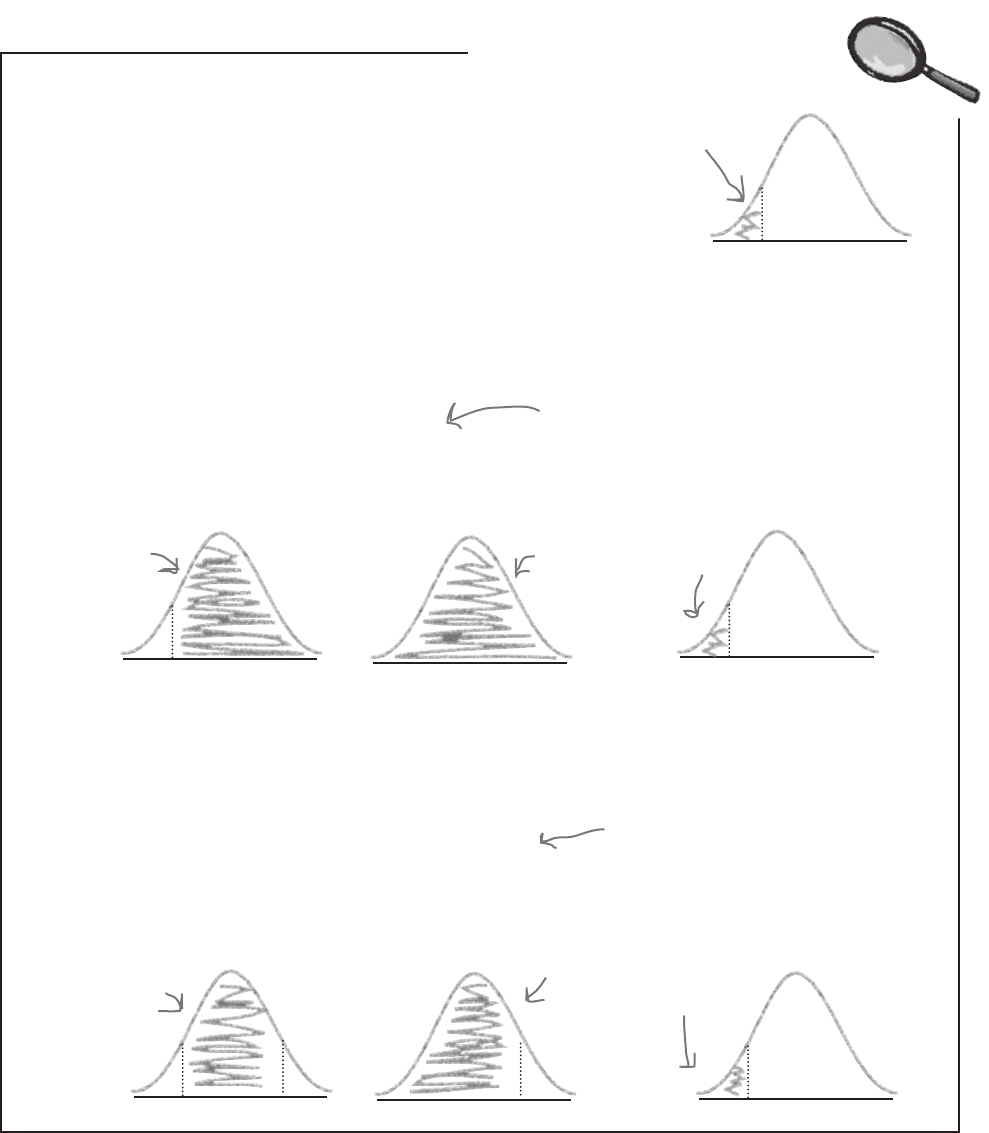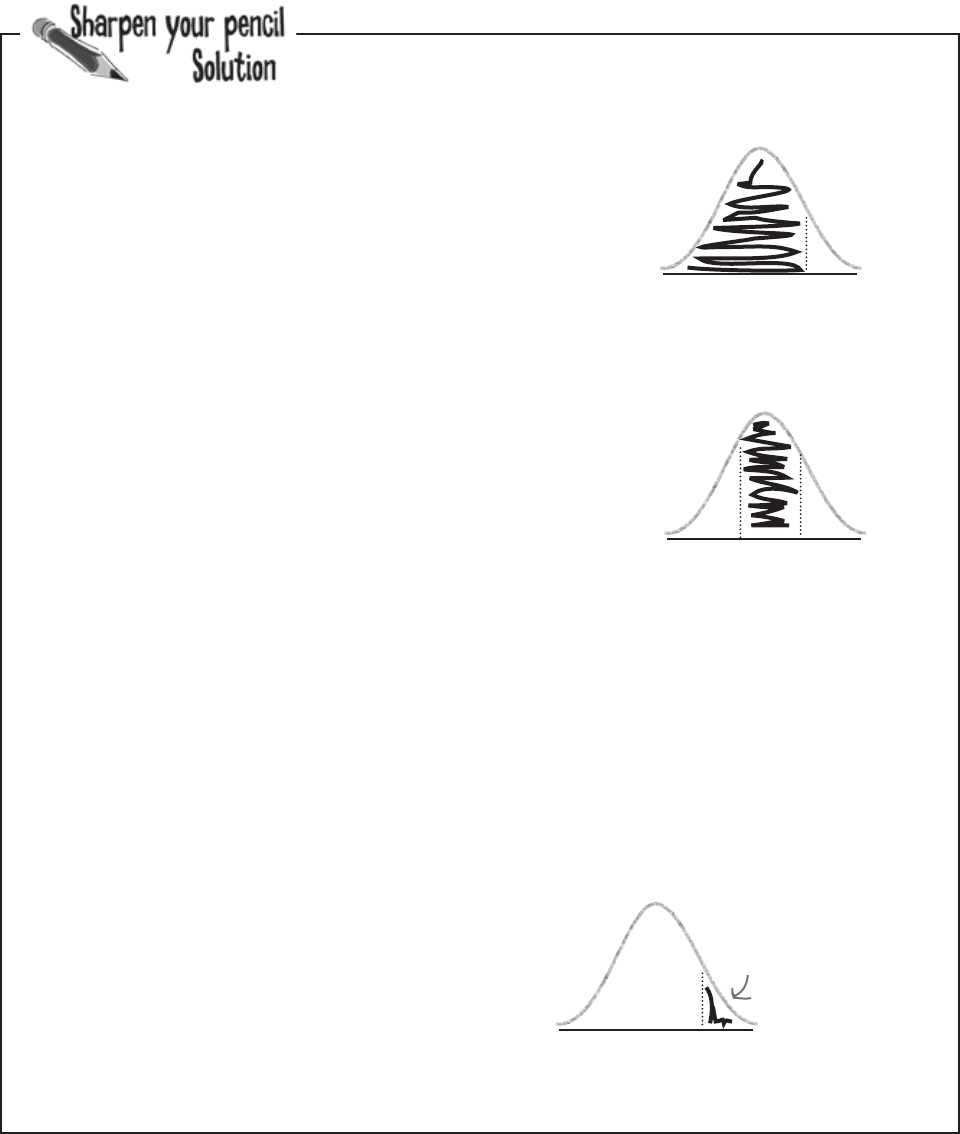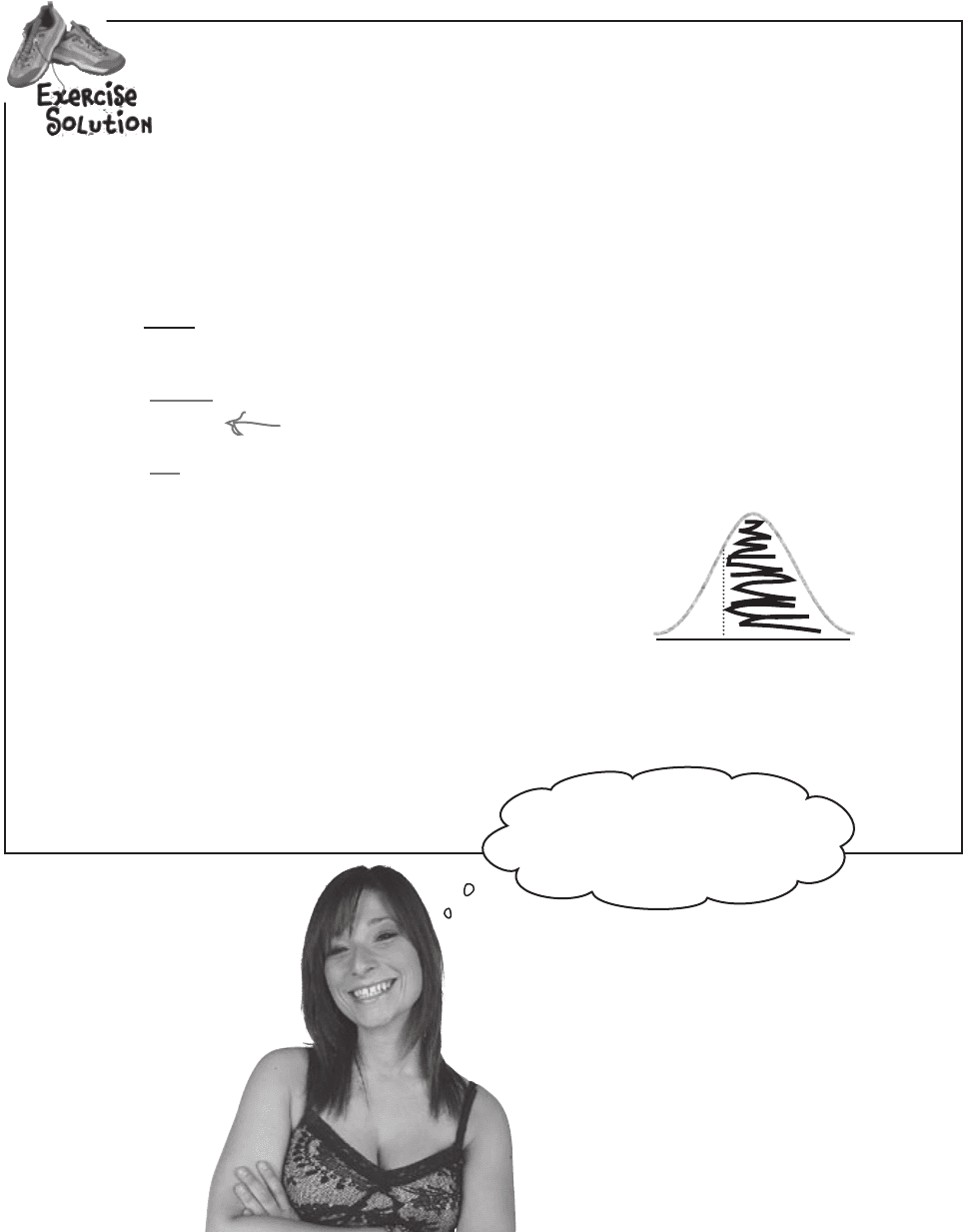Griffiths D. Head First Statistics
Подождите немного. Документ загружается.


you are here 4 351
using the normal distribution
z
Probability tables allow you to look up the probability P(Z < z) where
z is some value. The problem is you don’t always want to find this
sort of probability; sometimes you want to find the probability that a
continuous random variable is greater than z, or between two values.
How can you use probability tables to find the probability you need?
The big trick is to find a way of using the probability tables to get to
what you want, usually by finding a whole area and then subtracting
what you don’t need.
Probability tables give
us this probability.
Finding P(Z > z)
We can find probabilities of the form P(Z > z) using
In other words, take the area where Z < z away from the total probability.
Finding P(a < Z < b)
Finding this sort of probability is slightly more complicated to calculate,
but it’s still possible. You can calculate this sort of probability using
In other words, calculate P(Z < b), and take away the area for P(Z < a).
=
–
=
–
P(a < Z < b)
P(Z < b)
P(Z < a)
P(Z > z)
1
P(Z < z)
We’ve already used this to find
the probability that Julie is
taller than her date.
P(Z > z) = 1 - P(Z < z)
P(a < Z < b) = P(Z < b) - P(Z < a)
Probability Tables Up Close
You could use this to find the
probability that the height of Julie’s
date is within a particular range.
z
z
a
b
b
a

352 Chapter 8
Q:
I’ve heard of the term “Gaussian.”
What’s that?
A: Another name for the normal
distribution is the Gaussian distribution. If
you hear someone talking about a Gaussian
distribution, they’re talking about the same
thing as the normal distribution.
Q:
Are all normal probability tables the
same?
A: All normal probability tables give the
same probabilities for your values. However,
there’s some variation between tables as to
what’s actually covered by them.
Q:
Variation? What do you mean?
A: Some tables and exam boards use
different degrees of accuracy in their
probability tables. Also, some show the
tables in a slightly different format, but still
give the same information.
Q:
So what should I do if I’m taking a
statistics exam?
A: First of all, check what format of
probability table will be available to you while
you’re sitting the exam. Then, see if you can
get a copy.
Once you have a copy of the probability
tables used by your exam board, spend time
getting used to using them. That way you’ll
be off to a flying start when the exam comes
around.
Q:
Finding the probability of a range
looks kinda tricky. How do I do it?
A: The big thing here is to think about
how you can get the area you want using
the probability tables. Probability tables
generally only give probabilities in the form
P(Z < z) where z is some value. The big trick,
then, is to rewrite your probability only in
these terms.
If you’re dealing with a probability in the form
P(a < Z < b)—that is, some sort of range—
you’ll have two probabilities to look up, one
for P(Z < a) and the other for P(Z < b). Once
you have these probabilities, subtract the
smallest from the largest.
Q:
Do continuous distributions have
a mode? Can you find the mode of the
normal distribution?
A: Yes. The mode of a continuous
probability distribution is the value where
the probability density is highest. If you draw
the probability density, it’s the value of the
highest point of the curve.
If you look at the curve of the normal
distribution, the highest point is in the middle.
The mode of the normal distribution is μ.
Q:
What about the median?
A: The median of a continuous probability
distribution is the value a where
P(X < a) = 0.5. In other words, it’s the value
that area of the probability density curve in
half.
For the normal distribution, the median is
also μ. The median and mode don’t get used
much when we’re dealing with continuous
probability distributions. Expectation and
variance are more important.
Q:
What’s a standard score?
A: The standard score of a variable is
what you get if you subtract its mean and
divide by its standard deviation. It’s a way
of standardizing normal distributions so
that they are transformed into a N(0, 1)
distribution, and that gives you a way of
comparing them. Standard scores are
useful when you’re dealing with the normal
distribution because it means you can look
up the probability of a range using standard
normal probability tables.
The standard score of a particular value also
describes how many standard deviations
away from the mean the value is, which
gives you an idea of its relative proximity to
the mean.
no dumb questions

you are here 4 353
using the normal distribution
It’s time to put your probability table skills to the test. See if you
can solve the following probability problems.
1. P(Z < 1.42)
2. P(-0.15 < Z < 0.5)
3. P(Z > z) = 0.1423. What’s z?

354 Chapter 8
It’s time to put your probability table skills to the challenge. See
if you can solve the following probability problems.
1. P(Z < 1.42)
We can find this probability by looking up 1.42 in the
probability tables. This gives us
P(Z < 1.42) = 0.9222
2. P(-0.15 < Z < 0.5)
For this one, look up P(Z < 0.5), and subtract P(Z < -0.15)
P(-0.15 < Z < 0.5 = P(Z < 0.5) - P(Z < -0.15)
= 0.6915 - 0.4404
= 0.2511
3. P(Z > z) = 0.1423. What’s z?
P(Z > z) = 0.1423
This is a slightly different problem. We’re given the
probability, and need to find the value of z.
We know that P(Z > z) = 0.1423, which means that
P(Z < z) = 1 - 0.1423
= 0.8577
T
he next thing to do is find which value of z has
a probability of 0.8577. Looking this up in the
probability tables gives us
z = 1.07
so
P(Z > 1.07) = 0.1423
1.42
0.5
-.015
z
sharpen solution

you are here 4 355
using the normal distribution
Julie has a problem. When we calculated the probability of her date
being taller than her, we failed to take her high heels into account.
See if you can find the probability of Julie’s date being taller than
her while she’s wearing shoes with 5 inch heels.
As a reminder, Julie is 64 inches tall and X ~ N(71, 20.25) where X
is the height of men in Statsville.
Wait a sec, if I wear my
5-inch heels, I’m much taller.
Won’t that affect the probability
that my date is taller than me?

356 Chapter 8
Julie has a problem. When we calculated the probability of her date being taller than her, we
failed to take her high heels into account. See if you can find the probability of Julie’s date being
taller than her while she’s wearing shoes with 5 inch heels.
As a reminder, Julie is 64 inches tall and X ~ N(71, 20.25) where X is the height of men in
Statsville.
When Julie is wearing 5 inch high heels, her height is 69 inches. We need to find P(X > 69).
We need to start by finding the standard score of 178 so that we can use probability tables to look up the
probabilities.
Z = X - μ
= 69 - 71
4.5
= -2
4.5
= -0.44 (t
o 2 decima
l places)
Now we’ve found z, we need to find P(Z > z) i.e. P(Z > -0.44)
P(Z > -0.44) = 1 - P(Z < -0.44)
= 1 - 0.3300
= 0.67
So the probability that Julie’s date is taler than her when she’s wearing shoes with a 5 inch heel is 0.67.
The variance is 20.25, so the standard
deviation is the square root, 4.5.
-0.44
exercise solution
So, I can wear my highest heels,
and there’s still a 67% chance
he’ll be taller? Sweet!
σ

you are here 4 357
using the normal distribution
The Case of the Missing Parameters
Will at Manic Mango Games has a problem. He needs to give his
boss the mean and standard deviation of the number of minutes
people take to complete level one of their new game. This shouldn’t
be difficult, but unfortunately a ferocious terrier has eaten the piece of
paper he wrote them on.
Will only has three clues to help him.
First of all, Will knows that the number of minutes people spend
playing level one follows a normal distribution.
Secondly, he knows that the probability of a player playing for
less than 5 minutes is 0.0045.
Finally, the probability of someone taking less than 15 minutes to
complete level one is 0.9641.
How can Will find the mean and standard deviation?
Five Minute
Mystery
Five Minute
Mystery

358 Chapter 8
The Case of the Missing Parameters: Solved
How can Will find the mean and standard deviation?
Will can use probability tables and standard scores to get expressions for
the mean and standard deviation that he can then solve.
First of all, we know that P(X < 5) = 0.0045. From
probability tables, P(X < z
1
) where z
1
= -2.61, which
means that the standard score of 5 is -2.61. If we put
this into the standard score formula, we get
-2.61 = 5 - μ
σ
Similarly, P(X < 15) = 0.9641, which means that the standard score of
15 is 1.8. This gives us
1.8 = 15 - μ
σ
This gives us two equations we can solve to find μ and σ.
-2.61σ = 5 - μ
1.8σ = 15 - μ
If we subtract the first equation from the second, we get
1.8σ + 2.61σ = 15 - μ - 5 + μ
4.41σ = 10
σ = 2.27
If we then substitute this into the second equation, we get
1.8
×
2.27 = 15 - μ
μ = 15 - 4.086
= 10.914
In other w
ords,
μ = 10.914
σ = 2.27
Five Minute
Mystery
Solved
Five Minute
Mystery
Solved
This is a pair of equations
we can now solve.
These are the values of μ and σ.
five minute mystery solution

you are here 4 359
using the normal distribution
And they all lived happily ever after
Just as the odds predicted, Julie’s latest blind date was a success! Julie had
to make sure her intended soulmate was compatible with her shoes, so she
made sure she wore her highest heels to put him to the test. What’s more,
he was already at the venue when she arrived, so she didn’t have to wait
around.
The first thing he said to me
was how much he liked my shoes.
We’re clearly made for each other.
We’re not entirely sure
whether she’s referring to
her date or her shoes, but
at least she’s happy.
But it doesn’t stop there.
Keep reading and we’ll show you more things you can do
with the normal distribution. You’ve only just scratched the
surface of what you can do.
The normal distribution forms the shape of a
symmetrical bell curve. It’s defined using N(μ, σ
2
).
To find normal probabilities, start by identifying the
probability range you need. Then find the standard score
for the limit of this range using
Z = X - μ where Z ~ N(0, 1).
σ
You find normal probabilities by looking up your standard
score in probability tables. Probability tables give you
the probability of getting this value or lower.
